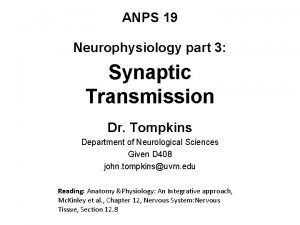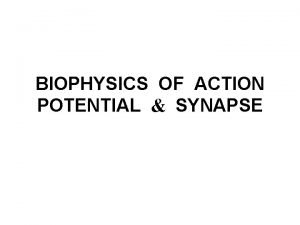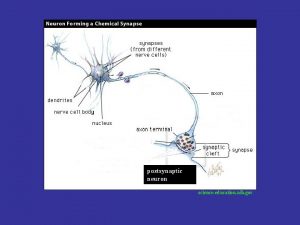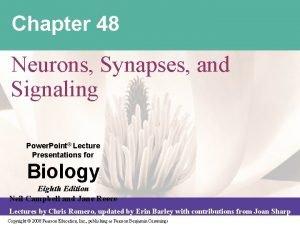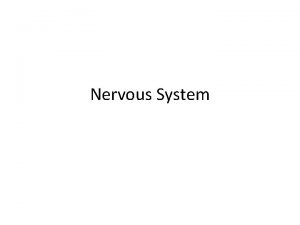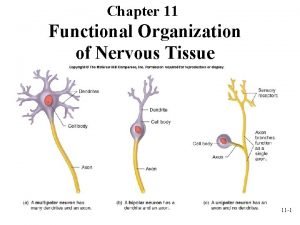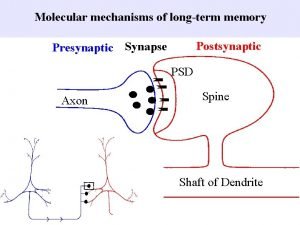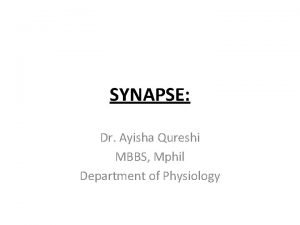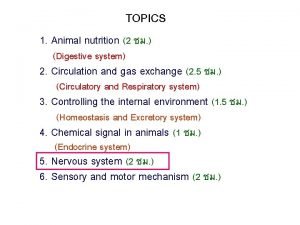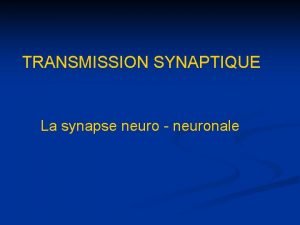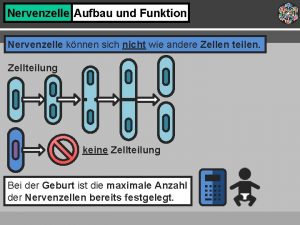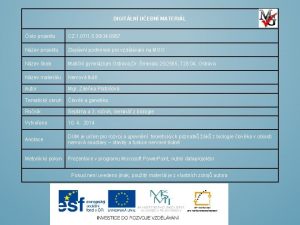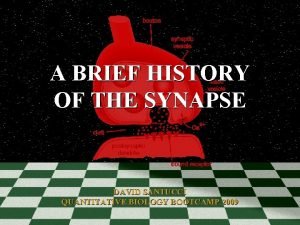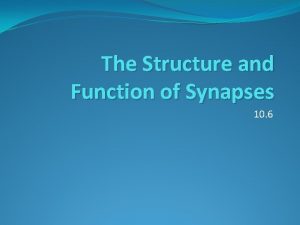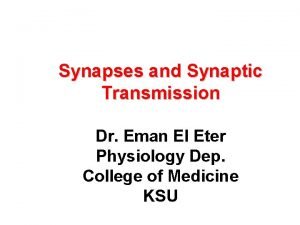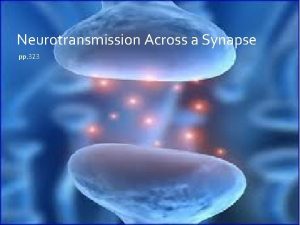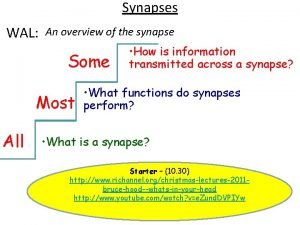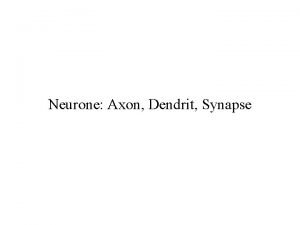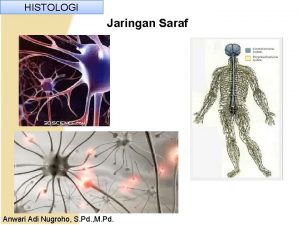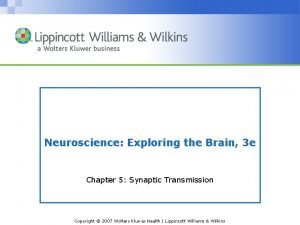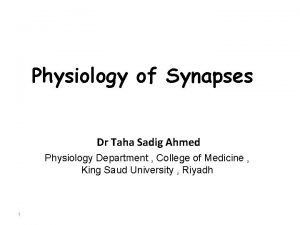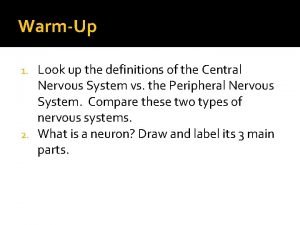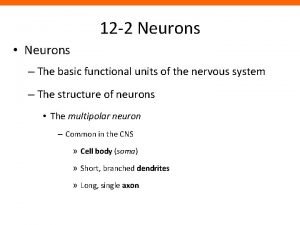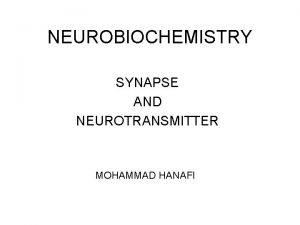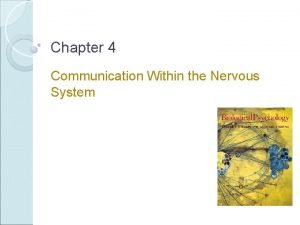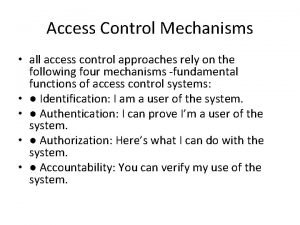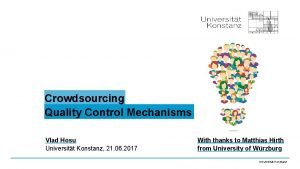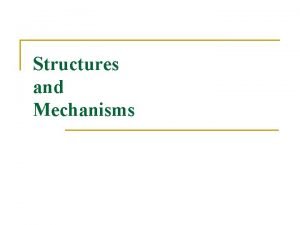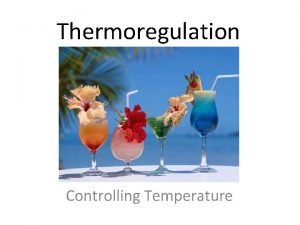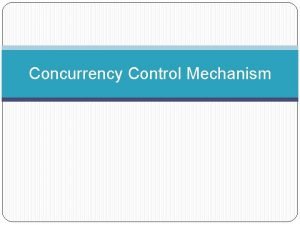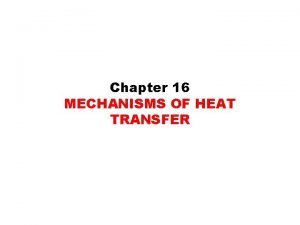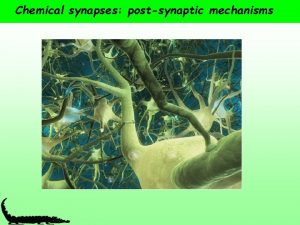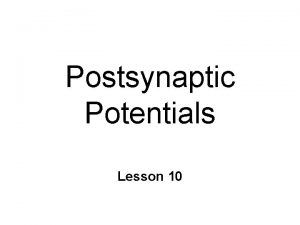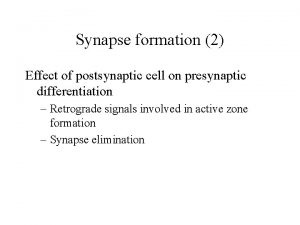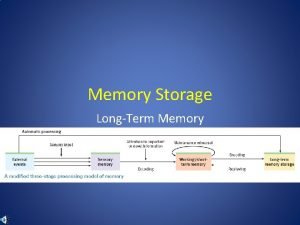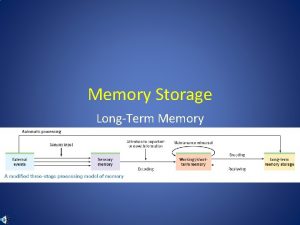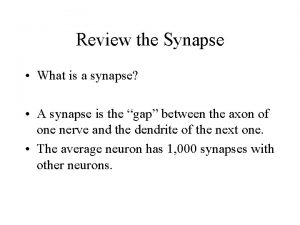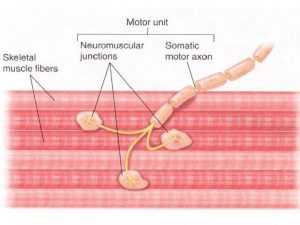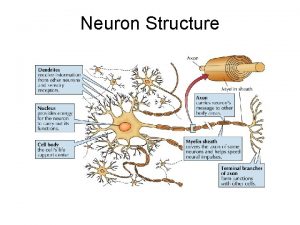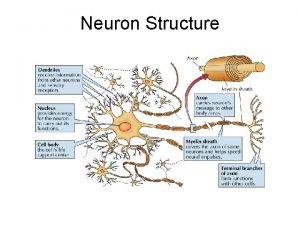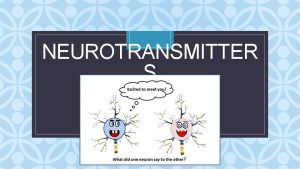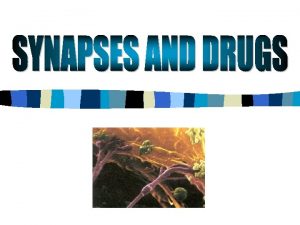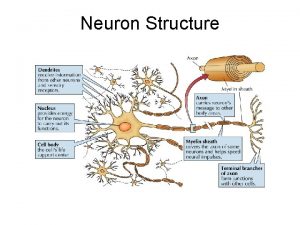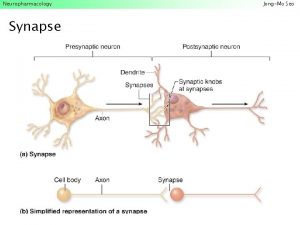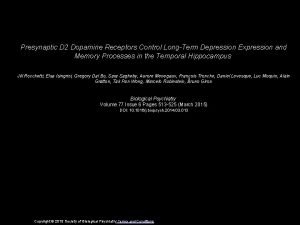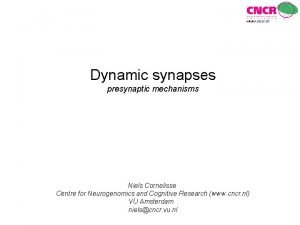Molecular mechanisms of longterm memory Postsynaptic Presynaptic Synapse






![Bistability in total phosphorylation of Ca. MKII [Ca 2+]=0. 1 M (basal level) Total Bistability in total phosphorylation of Ca. MKII [Ca 2+]=0. 1 M (basal level) Total](https://slidetodoc.com/presentation_image_h/164272142cf4aece0067d33c5f32ace7/image-7.jpg)
![Phosphorylation dominates at high calcium [Ca 2+] = 2 M (for LTP) Total reaction Phosphorylation dominates at high calcium [Ca 2+] = 2 M (for LTP) Total reaction](https://slidetodoc.com/presentation_image_h/164272142cf4aece0067d33c5f32ace7/image-8.jpg)

![How to get bistability 1) Autocatalysis: k+ increases with [C] 2) Saturation: total rate How to get bistability 1) Autocatalysis: k+ increases with [C] 2) Saturation: total rate](https://slidetodoc.com/presentation_image_h/164272142cf4aece0067d33c5f32ace7/image-10.jpg)
























































- Slides: 66

Molecular mechanisms of long-term memory Postsynaptic Presynaptic Synapse PSD Axon Spine Shaft of Dendrite

LTP: an increase in synaptic strength Long-term potentiation (LTP) Postsynaptic current LTP protocol induces postynaptic influx of Ca 2+ 0 Time (mins) Bliss and Lomo J Physiol, 1973 60

LTP: an increase in synaptic strength Long-term potentiation (LTP) Postsynaptic current LTP protocol induces postynaptic influx of Ca 2+ with Ca. MKII inhibitor or knockout 0 Time (mins) 60 Lledo et al PNAS 1995, Giese et al Science 1998

Calcium-calmodulin dependent kinase II (Ca. MKII) One holoenzyme = 12 subunits Kolodziej et al. J Biol Chem 2000

Model of bistability in the Ca. MKII-PP 1 system: autocatalytic activation and saturating inactivation. a) Autophosphorylation of Ca. MKII (2 rings per holoenzyme): P 0 P 1 slow P 2 P 1 fast Lisman and Zhabotinsky, Neuron 2001

b) Dephosphorylation of Ca. MKII by PP 1 (saturating inactivation) E = phosphatase, PP 1 k 2 k-1 Total rate of dephosphorylation can never exceed k 2. [PP 1] Leads to cooperativity as rate per subunit goes down Stability in spite of turnover
![Bistability in total phosphorylation of Ca MKII Ca 20 1 M basal level Total Bistability in total phosphorylation of Ca. MKII [Ca 2+]=0. 1 M (basal level) Total](https://slidetodoc.com/presentation_image_h/164272142cf4aece0067d33c5f32ace7/image-7.jpg)
Bistability in total phosphorylation of Ca. MKII [Ca 2+]=0. 1 M (basal level) Total reaction rate Rate of dephosphoryation Rate of phosphorylation 0 0 No. of active subunits 12 N
![Phosphorylation dominates at high calcium Ca 2 2 M for LTP Total reaction Phosphorylation dominates at high calcium [Ca 2+] = 2 M (for LTP) Total reaction](https://slidetodoc.com/presentation_image_h/164272142cf4aece0067d33c5f32ace7/image-8.jpg)
Phosphorylation dominates at high calcium [Ca 2+] = 2 M (for LTP) Total reaction rate Rate of dephosphoryation Rate of phosphorylation 0 0 No. of active subunits 12 N

The “Normal” State of Affairs (one stable state, no bistability)
![How to get bistability 1 Autocatalysis k increases with C 2 Saturation total rate How to get bistability 1) Autocatalysis: k+ increases with [C] 2) Saturation: total rate](https://slidetodoc.com/presentation_image_h/164272142cf4aece0067d33c5f32ace7/image-10.jpg)
How to get bistability 1) Autocatalysis: k+ increases with [C] 2) Saturation: total rate down, (k-)[C], is limited

Reaction pathways 14 configurations of phosphorylated subunits per ring P 0 P 1 P 2 P 3 P 4 P 5 P 6

Phosphorylation to clockwise neighbors P 0 P 1 P 2 P 3 P 4 P 5 P 6

Phosphorylation to clockwise neighbors P 0 P 1 P 2 P 3 P 4 P 5 P 6

Random dephosphorylation by PP 1 P 0 P 1 P 2 P 3 P 4 P 5 P 6

Random dephosphorylation by PP 1 P 0 P 1 P 2 P 3 P 4 P 5 P 6

Random turnover included P 0 P 1 P 2 P 3 P 4 P 5 P 6

Stability of DOWN state = PP 1 enzyme

Stability of DOWN state = PP 1 enzyme

Stability of DOWN state = PP 1 enzyme

Stability of UP state = PP 1 enzyme

Stability of UP state = PP 1 enzyme

Stability of UP state = PP 1 enzyme

Stability of UP state = PP 1 enzyme

Stability of UP state = PP 1 enzyme

Protein turnover = PP 1 enzyme

Stability of UP state with turnover = PP 1 enzyme

Stability of UP state = PP 1 enzyme

Stability of UP state = PP 1 enzyme

Stability of UP state = PP 1 enzyme

Stability of UP state = PP 1 enzyme

Stability of UP state = PP 1 enzyme

Stability of UP state = PP 1 enzyme

Stability of UP state = PP 1 enzyme

Stability of UP state = PP 1 enzyme

Stability of UP state = PP 1 enzyme

Stability of UP state = PP 1 enzyme

Small numbers of Ca. MKII holoenzymes in PSD Petersen et al. J Neurosci 2003

Simulation methods Stochastic implementation of reactions, of rates Ri(t) using small numbers of molecules via Gillespie's algorithm: 1) Variable time-steps, ∆t: P(∆t) = ∑Ri exp(-∆t ∑Ri) 2) Probability of specific reaction: P(Ri) = Ri/∑Ri 3) Update numbers of molecules according to reaction chosen 4) Update reaction rates using new concentrations 5) Repeat step 1)

Fraction of subunits phosphorylated System of 20 holoenzymes undergoes stable LTP 1 Pulse of high Ca 2+ here 0 0 10 Time (yrs) 20

Fraction of subunits phosphorylated Slow transient dynamics revealed Time (mins)

Fraction of subunits phosphorylated Spontaneous transitions in system with 16 holoenzymes Time (yrs)

Fraction of subunits phosphorylated Spontaneous transitions in system with 4 holoenzymes Time (days)

Average lifetime between transitions increases exponentially with system size

Effective potential Reaction rates Large-N limit, like hopping over a potential barrier 0 No. of active subunits 12 N

1) Chemical reactions in biology: x-axis = “reaction coordinate” = amount of protein phosphorylation 2) Networks of neurons that “fire” action potentials: x-axis = average firing rate of a group of neurons

Why is this important? Transition between states = loss of memory Transition times determine memory decay times.

Something like physics Barrier height depends on area between “rate on” and “rate off” curves, which scales with system size.

Physics analogy: barriers with noise. . . Inherent noise because reactions take place one molecule at a time. Rate of transition over barrier decreases exponentially with barrier height. . . (like thermal physics, with a potential barrier, U and thermal noise energy proportional to k. T ) ?

General result for memory systems Time between transitions increases exponentially with scale of the system. Scale = number of molecules in a biochemical system = number of neurons in a network Rolling dice analogy: number of rolls needed, each with probability, p to get N rolls in row, probability is p. N time to wait increases as (1/p)N = exp[N. ln(1/p)]

Change of concentration ratios affects balance between UP and DOWN states. System of 8 Ca. MKII holoenzymes: 9 PP 1 enzymes Phosphorylation fraction 7 PP 1 enzymes Time (yrs)

Optimal system lifetime is a trade-off between lifetimes of UP and DOWN states Average lifetime of state 10 yrs DOWN state lifetime 1 yr 1 mth UP state lifetime 1 day Number of PP 1 enzymes

Optimal system lifetime is a trade-off between lifetimes of UP and DOWN states Average lifetime of state 10 yrs DOWN state lifetime 1 yr 1 mth UP state lifetime 1 day Number of PP 1 enzymes

Preceding a switch down Turnover Time (hrs) No. of active subunits, single ring Total no. of active subunits Analysis: Separate time-scale for ring switching In stable UP state Turnover Time (hrs)


Analysis: Separate time-scale for ring switching Goal Rapid speed-up by converting system to 1 D and solving analytically. Method Essentially a mean-field theory. Justification Changes to and from P 0 (unphosphorylated state) are slow.

Analysis: Project system to 1 D 1) Number of rings “on” with any activation, n. 2) Assume average number, P, of subunits phosphorylated for all rings “on”. 3) Calculate reaction rates for one ring, assuming contibution of others is (n-1)P. 4) Calculate average time in configurations with these reaction rates. 5) Hence calculate new value of P. 6) Repeat Step 2 until convergence. 7) Calculate rate to switch “on”, r+n, and “off”, r-n. 8) Continue with new value of n.

Analysis: Project system to 1 D 1) Number of rings “on” with any activation, n. 2) Assume average number, P, of subunits phosphorylated for all rings “on”. 3) Calculate reaction rates for one ring, assuming contibution of others is (n-1)P. 4) Calculate average time in configurations with these reaction rates. 5) Hence calculate new value of P. 6) Repeat Step 2 until convergence. 7) Calculate rate to switch “on”, r+n, and “off”, r-n. 8) Continue with new value of n.

Analysis: Project system to 1 D 1) Number of rings “on” with any activation, n. 2) Assume average number, P, of subunits phosphorylated for all rings “on”. 3) Calculate reaction rates for one ring, assuming contibution of others is (n-1)P. 4) Calculate average time in configurations with these reaction rates. 5) Hence calculate new value of P. 6) Repeat Step 2 until convergence. 7) Calculate rate to switch “on”, r+n, and “off”, r-n. 8) Continue with new value of n.

Analysis: Project system to 1 D 1) Number of rings “on” with any activation, n. 2) Assume average number, P, of subunits phosphorylated for all rings “on”. 3) Calculate reaction rates for one ring, assuming contibution of others is (n-1)P. 4) Calculate average time in configurations with these reaction rates. 5) Hence calculate new value of P. 6) Repeat Step 2 until convergence. 7) Calculate rate to switch “on”, r+n, and “off”, r-n. 8) Continue with new value of n.

Analysis: Project system to 1 D 1) Number of rings “on” with any activation, n. 2) Assume average number, P, of subunits phosphorylated for all rings “on”. 3) Calculate reaction rates for one ring, assuming contibution of others is (n-1)P. 4) Calculate average time in configurations with these reaction rates. 5) Hence calculate new value of P. 6) Repeat Step 2 until convergence. 7) Calculate rate to switch “on”, r+n, and “off”, r-n. 8) Continue with new value of n.

Analysis: Project system to 1 D 1) Number of rings “on” with any activation, n. 2) Assume average number, P, of subunits phosphorylated for all rings “on”. 3) Calculate reaction rates for one ring, assuming contibution of others is (n-1)P. 4) Calculate average time in configurations with these reaction rates. 5) Hence calculate new value of P. 6) Repeat Step 2 until convergence. 7) Calculate rate to switch “on”, r+n, and “off”, r-n. 8) Continue with new value of n.

Analysis: Project system to 1 D 1) Number of rings “on” with any activation, n. 2) Assume average number, P, of subunits phosphorylated for all rings “on”. 3) Calculate reaction rates for one ring, assuming contibution of others is (n-1)P. 4) Calculate average time in configurations with these reaction rates. 5) Hence calculate new value of P. 6) Repeat Step 2 until convergence. 7) Calculate rate to switch “on”, r+n, and “off”, r-n. 8) Continue with new value of n.

Analysis: Project system to 1 D 1) Number of rings “on” with any activation, n. 2) Assume average number, P, of subunits phosphorylated for all rings “on”. 3) Calculate reaction rates for one ring, assuming contibution of others is (n-1)P. 4) Calculate average time in configurations with these reaction rates. 5) Hence calculate new value of P. 6) Repeat Step 2 until convergence. 7) Calculate rate to switch “on”, r+n, and “off”, r-n. 8) Continue with new value of n.

Analysis: Solve 1 D model exactly r+n-1 N 0 n-1 n - rn r+n+1 r+ n n+1 r-n+1 n+2 r-n+2 Time to hop from N 0 to N 1 Use: r+n Tn = 1 + r-n+1 Tn+1 for N 0 ≤ n < N 1 r+n Tn = r-n+1 Tn+1 for n < N 0 Tn = 0 for n ≥ N 1 Average total time for transition, Ttot = ∑Tn N 1

Optimal system lifetime is a trade-off between lifetimes of UP and DOWN states Average lifetime of state 10 yrs DOWN state lifetime 1 yr 1 mth UP state lifetime 1 day Number of PP 1 enzymes

Optimal system lifetime is a trade-off between lifetimes of UP and DOWN states Average lifetime of state 10 yrs DOWN state lifetime 1 yr 1 mth UP state lifetime 1 day Number of PP 1 enzymes
 Spatial summation
Spatial summation Chemical synapses
Chemical synapses Presynaptic vesicles
Presynaptic vesicles Summation of postsynaptic potentials
Summation of postsynaptic potentials Years solitary confinement
Years solitary confinement Postsynaptic neuron
Postsynaptic neuron Kernel longterm
Kernel longterm Postsynaptic potentials
Postsynaptic potentials Postsynaptic membrane
Postsynaptic membrane Function of multipolar neuron
Function of multipolar neuron Postsynaptic
Postsynaptic Epsp vs ipsp
Epsp vs ipsp Zinc oxide + nitric acid → zinc nitrate + water
Zinc oxide + nitric acid → zinc nitrate + water Melting and boiling point of oxygen
Melting and boiling point of oxygen Giant molecular structure vs simple molecular structure
Giant molecular structure vs simple molecular structure Integration center
Integration center Synapse neuro neuronale
Synapse neuro neuronale Slidetodoc.com
Slidetodoc.com Synapse
Synapse Synapse
Synapse Synapse functions
Synapse functions Conjoint synapse example
Conjoint synapse example Synapse
Synapse Functions of the synapse
Functions of the synapse Schmidt lantermann einkerbungen
Schmidt lantermann einkerbungen Histologi neuron
Histologi neuron Synapse
Synapse Synapse private cloud
Synapse private cloud Transmission across a synapse
Transmission across a synapse Chemical synapse
Chemical synapse Synapses
Synapses Synapse
Synapse Synapse machine learning
Synapse machine learning Bioflix how synapses work
Bioflix how synapses work Anaxonic neuron structure
Anaxonic neuron structure Inhibitory neurotransmitter
Inhibitory neurotransmitter Synapse
Synapse Synapse decompiler
Synapse decompiler Hpooll
Hpooll Axoaxonic
Axoaxonic Types of synapse
Types of synapse Eidetic memory vs iconic memory
Eidetic memory vs iconic memory Which memory is the actual working memory?
Which memory is the actual working memory? Internal memory and external memory
Internal memory and external memory Shared memory vs distributed memory
Shared memory vs distributed memory Semantic memory example
Semantic memory example Virtual memory and cache memory
Virtual memory and cache memory Primary memory and secondary memory
Primary memory and secondary memory Excplicit memory
Excplicit memory Virtual memory in memory hierarchy consists of
Virtual memory in memory hierarchy consists of Logical memory is broken into
Logical memory is broken into Long term memory vs short term memory
Long term memory vs short term memory Evolutionary mechanisms
Evolutionary mechanisms Freuds theories
Freuds theories Access control mechanism in networking
Access control mechanism in networking Vlad hosu
Vlad hosu Ego defense mechanisms
Ego defense mechanisms Provider payment mechanisms
Provider payment mechanisms Satalite weather
Satalite weather Structure and mechanism
Structure and mechanism Homeostasis mechanisms for regulation of body temperature
Homeostasis mechanisms for regulation of body temperature Example of regression defense mechanism
Example of regression defense mechanism Concurrency control mechanism
Concurrency control mechanism Example of freud theory
Example of freud theory Mechanism of heat transfer
Mechanism of heat transfer Mechanism of evolution
Mechanism of evolution Mechanisms of evolution
Mechanisms of evolution
